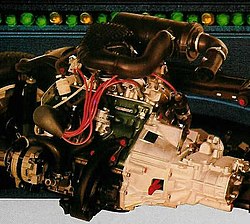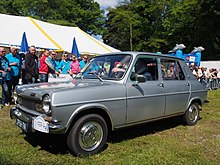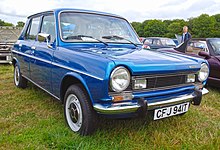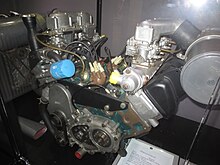Simca Poissy engine
|
Simca Talbot Groupe PSA |
|
|---|---|
|
Simca Poissy engine with flanged four-speed gearbox |
|
| Simca Poissy engine | |
| Production period: | 1961-1991 |
| Manufacturer: |
Simca Talbot Groupe PSA |
| Working principle: | Otto |
| Motor design: | line |
| Valve control: | OHV valve control |
| Displacement: | 777-1592 cm 3 |
| Mixture preparation: | Carburetor |
| Engine charging: | no |
| Power: | 25-88 kW |
| Previous model: | Simca Rush engine |
| Successor: | PSA-TU engine |
The Simca Poissy engine , commonly known as Simca 1100 engine was a water-cooled four-cylinder - OHV engine with two valves per cylinder, which by Simca developed for use in its small and compact cars, and by the engineer Georges Martin (V12 Matra Sports engine developer). Despite its common name, the engine actually goes back to use in the Simca 1100 , but was introduced in 1961 with the Simca 1000 Coupé . It was developed and produced by Simca (later renamed Talbot) in the late 1960s in the manufacturer's factory in Poissy , hence the name.
history
The engine was initially developed in a 944 cm³ variant with an output of 52 hp (38 kW) and presented in 1961 in the Simca 1000 Coupé, a small two-door sports model. In the following year, the 315 was used for the first time in a sedan, the newly developed small car Simca 1000 , in throttled form with only 34 hp (25 kW). It was used with smaller and larger displacements in a variety of models and versions, both by Simca, the Rootes Group ( Chrysler Europe's partner company ), Simca's successor brand Talbot and its last parent company, Peugeot , which until 1991 in their midsize model, the 309 , used. The engine existed with a displacement of 0.8 to 1.6 l (777 to 1592 cm³) on both sides of the Atlantic, the largest of which powered the US Dodge Omni / Plymouth Horizon .
Peugeot eventually discontinued the engines and replaced them with its own TU family .
Poissy engine
The series of these Simca engines, which were originally designed by the engineer Georges Martin (father of the V12 Matra sports engine), were characterized by their reliability, power and a remarkable torque for the displacement, but had the disadvantage of being very noisy.
The overhead camshaft type 315 engine was a modern, water-cooled four-cylinder in-line engine with a forged crankshaft , five crankshaft bearings , an aluminum cylinder head and two valves per cylinder. One of the most important innovations was the use of a swirl vortex on the inlet valve , which for this time enabled very good combustion and thus both performance and economy. The direction of rotation of this motor is clockwise (distributor side). For reasons of reliability, a double chain without a tensioner was preferred to a simple chain with a tensioner. Safety took precedence over comfort.
A special feature of early models was the lack of a screw-on paper oil filter . Instead, the engine featured some form of centrifugal oil filter in the hollow rear crankshaft pulley, all later versions had the traditional cartridge filters. This engine was Simca's entry into modern engine construction. The engine was the entry-level engine for the Simca 1100 until 1982; it was found to be inexpensive to manufacture and several models of different sizes and market segments took advantage of it.
In later years, when it was used in cars such as the Horizon and 1307 / Alpine / Solara, the Poissy motor was criticized for its poor mechanical properties - especially for its loud tappet noises, which led to poor press reports ("sewing machine"). Another point of criticism was the ignition distributor behind the radiator on the 1100, which caused ignition problems more often when it rained, which were only solved by a modern, powerful transistor ignition . As an entry-level engine, it was installed in the Peugeot 309 until 1991.
Smaller variants
The Poissy motor was scaled down several times, although it wasn't used much except in the early and more compact models. In 1964 Simca developed an 844 cc version for the Spanish Simca 1000, as cars over 0.9 l came into a higher tax class. This variant was available in two power levels, of which the most powerful with a double carburetor produced an output of 43 hp (32 kW). At the end of 1968 an even more economical version with only 777 cm³ was developed for the entire European market. These engines were used in the Simca 1000 until 1978.
Larger variants
In 1968 another version was developed for the Spanish market, the 1.2 l with 1204 cm³ displacement. This was the first sporty version of the 1000 with an output of 55 hp (40 kW). In the Simca 1200 S, a coupé designed by Bertone , and in the CG sports car , a double carburetor was used so that the engine could achieve 85 hp (63 kW). The regular version was later used in various models on the European market and even installed in the US market version of the Simca 1100 (Simca 1204). It was in use until 1978.
The 1.1-liter (1118-cm³) variant appeared in 1967, first in the 1100 and then in the 1000. This turned out to be one of the most popular variants of the 315 engines, which was also the LCV version of the 1100, known as the VF2 , and powered the entry-level version of the Talbot Horizon . It survived until 1991 when it was used as the base model for the Peugeot 309.
The 1.3L (1294cc) version was introduced in 1972, and although it wasn't very popular in the 1000, it continued to be used in various Simca and Talbot models. Famous in racing circles, it served as the drive for the Simca Rallye II , a sporty version of the 1000 series introduced in 1972 with two double carburetors and a maximum output of 82 hp (60 kW). Racing versions could be tuned with significantly more than 120 hp (88 kW), and the three generations of the Simca Rallye with this engine are still used throughout Europe, particularly in France, in various national rally championships for vintage and non- homologated cars .
The 1.4 l (1442 cm³) variant was first used in 1975 in the Simca 1307 / Chrysler Alpine . Because of its size, it was able to achieve 85 hp (63 kW) with a twin carburetor, but unlike the 1.3 liter version, it was never used for racing in any version, Simca and Talbot prefer to use it in their larger models, including the Luxury versions of the Horizon and the Solara . It also powered Europe's first compact SUV, the Matra Rancho .
The largest version of the Poissy engine was the 1.6 l (1592 cm³) variant. Like the 1.45 liter engine, it made its debut in 1975 in the 1307 SX / Alpine and was put at the top of the product range, initially only with an automatic transmission , which was necessary to ensure that this engine was the US versions of Chrysler-Europe -Models could drive. Notorious for its use in the Dodge Omni and Plymouth Horizon , it was called Peugeot by the American media, although Peugeot had nothing to do with its design. It was also used as the base engine for the three-seat Matra Murena coupe .
The different models
According to the workshop manual for the “moteur Poissy” (French edition).
| Engine designation | 359 | 315 - D | 350 - 351 - E. | 354-353 - F. | 366-371 - G. | Y | J | U8 (prototype) |
|---|---|---|---|---|---|---|---|---|
| Displacement | 777 cc | 944 cc | 1118 cc | 1204 cc | 1294 cc | 1442 cc | 1592 cm³ | 2588 cc |
| Stroke (mm) | 68 | 68 | 74 | 74 | 76.7 | 76.7 | 80.6 | 76.7 |
| Bore (mm) | 53.5 | 65 | 65 | 70 | 70 | 78 | 78 | 70 |
777 cc
This smallest model was a special tax model introduced at the end of 1968, with which the Simca 1000 was classified in the French 4CV tax class. The engine code is type 359 .
- Simca 1000 - 1968-1978
844 cc
This special tax model was only offered for the Spanish market, where cars with a displacement larger than 850 cm³ were taxed higher. It was called the Simca 900 and was introduced with this engine in 1970. In 1973 it was presented again as the 900 Spécial, this time with a Bressel 32 twin carburetor and with 43 hp (32 kW) at 5800 rpm.
- Simca 900 - 1970–1977 (Spain)
944 cc
This engine, which was introduced for longitudinal installation (for the 1000 series with rear engine), was given the name 315 . In 1968 a version for transverse mounting (for the new 1100 with front-wheel drive) was presented with the name Type 352 . Some of its improvements were also applied to the original version, which was now code 349 . In 1973 Simca changed its engine coding system and the longitudinal engine became the 1D1 and the transverse model became the 3D1 .
1118 cc
When used in Peugeots, the engine was called the E1A engine . It was originally designated as Type 350 (for transverse installation) or 351 (for longitudinal installation). These became the 3E1 and 1E1 in 1973.
- Simca 1000 - 1968-1978
- Simca 1100-1967-1982
- Simca-Talbot Horizon - 1977-1987
- Peugeot 205 - July 1987 - October 1988, some Spanish XL / GL models
- Peugeot 309 - 1986-1989
- Citroen C15 - 1987-1988
1204 cc
The 1.2 l versions with engine code 353 had a 70 mm longer stroke than the 1.1 l engine, and the 74 mm bore was retained. It was originally available in the somewhat sportier 1100 Spécial. The version for longitudinal installation in the rear was designated as 354. The engine code was later changed to 1F1 (for single-carburetor versions) and after the takeover of PSA it was briefly installed in the Spanish 205, where it was named F1 .
- Simca 1000 GT, Rally GT, Special (Spain only)
- Simca 1200S Bertone - 1968-1971
- Simca CG - 1967-1974
- Special - 1967-1979
- Simca VF2 - 1973-1985
- Peugeot 205 - 1987–1990, Spain only
- Peugeot 309 - Spain only
1294 cc
The 1.3-l version was introduced in 1971 and replaced the 1.2-l version used earlier. The bore was increased to 76.7 mm while the stroke remained at 70 mm. The engine code was 366 for transverse installations, while longitudinal engines were designated as Type 371. In 1973 Simca changed its system and the engines became 3G (transversal) and 1G (longitudinal) instead. After PSA began to link its activities more closely with those of the former Simca group, the engine code was again changed to G1A in order to use it for use in the 309 and the later Horizons. The 1978 Simca 1000 Rallye III had the most powerful unit to date, the 1G4C .
- Simca 1000 - 1972-1974
- Simca Rally - 1972-1978
- Simca 1100 Special - 1971–1982
- Simca 1307 / Chrysler Alpine / Talbot 1510 - 1975–1982
- Matra Bagheera - 1973-1976
- Simca-Talbot Horizon - 1977-1985
- Talbot Solara - 1980–1985
- Peugeot 205 - Spanish XR / GR models
- Peugeot 309 - 1986-1989
- Citroen C15 - 1987-1988
1442 cc
This larger model, introduced in 1975, has engine code 6Y . The 6Y1 has a single carburetor, while the 6Y2 has a double carburetor and the 6Y4 has two double carburetors.
- Simca 1200 - Spain, 1979-1980
- Simca 1307 / Chrysler Alpine / Talbot 1510 - 1975–1983
- Matra Bagheera - 1976-1980
- Matra Rancho - 1977-1982
- Simca-Talbot Horizon - 1977-1987
- Talbot Solara - 1980-1986
- Peugeot 205 - some Spanish models
1592 cm³
This engine was called internally 6J . 6J1 engines have a single carburetor while 6J2 engines have a double carburetor. The slightly more powerful version with 92 PS (68 kW) in the Murena was called the 6J2A.
- Simca 1309 / Chrysler Alpine / Talbot 1510 - 1978–1984
- Matra Murena - 1980-1983
- Talbot Horizon - 1983-1987
- Dodge Omni / Plymouth Horizon - 1983-1986
- Talbot Solara - 1980-1986
- Peugeot 205 GTX (Spain, 1987 - October 1991)
U8 (prototype)
After the Bagheera with a 1294 cc engine and 84 hp with the engine from the Simca 1100 TI was presented in April 1973, Matra announced a GT version with a large-volume engine. In July 1973, Matra presented the prototype: the Bagheera U8.
The idea of Georges Pinardeaud, assistant to Philippe Guidon, and his team was this: to mount two 1294 cc blocks in a common housing in order to double power and torque. The Simca 1000 Rallye 2 engine was supplemented by a Bagheera engine, which was identical except for the direction of rotation. The ignition system in the middle and the air filters on each side were beneficial. A common housing with a gear connection was created to couple the two crankshafts, but for reasons of reliability it was replaced by a so-called tornado chain, each of which drove a central shaft. One chain connected the crankshaft to the central shaft on the left front, and another chain connected it to the back of the right crankshaft. The right engine received a 5-speed gearbox as well as the flywheel and the diaphragm clutch. There were two gasoline pumps with four twin Weber 36 DCNF carburetors and two air filters. The resulting 8-cylinder engine had a displacement of 2588 cm³ with a compression of 9.8 with an output of 168 HP (124 kW) and a maximum torque of 22 mkp (215 Nm) at 4000 / min.
The project lasted 18 months but was stopped by Chrysler due to budget constraints. However, the tests carried out showed that the Bagheera U8 could reach a top speed of 230 km / h with a fuel consumption of almost 28 liters. Two vehicles were built, one of which is on display in the “Espace automobiles Matra” in Romorantin , along with the famous U8 engine, which is one of the museum's mechanical “rarities”. The layout study model presented to the press in 1973 (based on a Bagheera with the tail cut off) was not motorized.
Web links
- Histoire de moteurs: le Simca Poissy - News d'Anciennes. In: newsdanciennes.com. August 1, 2017, accessed April 23, 2019 (French).
- lagriffe: Team Grente Associés. In: teamgrente.fr. Retrieved April 23, 2019 (French).
- The Matra Bagheera U8 project. In: rootes-chrysler.co.uk. Retrieved April 24, 2019 .
- Moteur Poissy. In: facebook.com. October 22, 2014, accessed April 24, 2019 .
Individual evidence
- ^ Andy Thompson: - covering Chrysler Europe, Rootes Group, and Talbot cars. In: rootes-chrysler.co.uk. Retrieved April 24, 2019 .
- ^ Benjamin: Histoire de moteurs: le Simca Poissy - News d'Anciennes. In: newsdanciennes.com. August 1, 2017, accessed April 24, 2019 (French).
- ↑ Manuel d'atelier: Moteur séries E, G, Y et J. Peugeot-Talbot, Édition française, 1984, référence 3130.
- ↑ a b Moteur Poissy: son histoire. In: simca-talbot-horizon.forumactif.com. Retrieved April 22, 2019 (French).
- ↑ Matra Bagheera. In: matra-passion.com. November 4, 2006, accessed April 22, 2019 (French).









